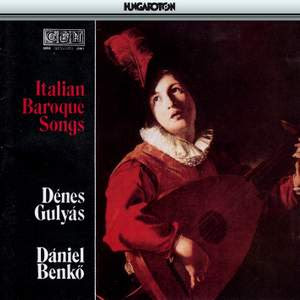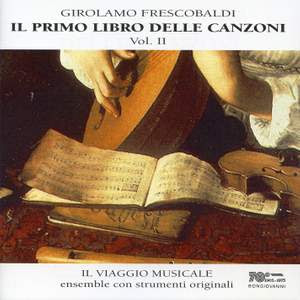Program: #94-07 Air Date: Feb 14, 1994
We are experiencing difficulties with our usual, more featureful audio player. We expect to fix this soon; until then, please enjoy the music with this 'classic' audio player.
This program is Free for all, thanks to this generous Preservation Grant:
I. Marco Uccellini: “La Bergamasca” (The Arcadian Academy/Nicholas McGegan). Harmonia Mundi CD 90756.
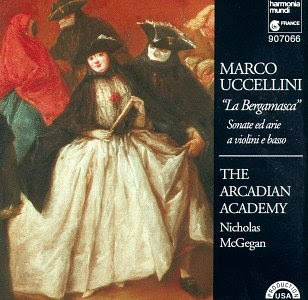
Marco Uccellini was a 17th Century Italian composer about whom little is known beyond an output of some 300 pieces that were reprinted many times during his life but therafter fell into neglect.
This is the first all-Uccellini CD, presenting 18 sonatas and arias for violins and bass continuo. It is a treasure. There's a vitality and richness to the music that goes beyond the boundaries of the Renaissance dance forms that appear in Uccellini's compositions, suggesting the level of invention that put his work into the first published collection of pieces for solo violin. McGegan and his colleagues-who all play with winning high spirits-have rediscovered a major figure.
| 1. | 3:58 | |||
|
2 |
5:28 |
|
||
|
3 |
2:44 | |||
|
4 |
4:06 | |||
|
5 |
4:05 | |||
|
6 |
4:05 |
|
||
|
7 |
3:20 |
|
||
|
8 |
4:02 |
|
||
|
9 |
3:01 | |||
|
10 |
2:49 |
|
||
|
11 |
4:13 | |||
|
12 |
4:42 | |||
|
13 |
8:04 | |||
|
14 |
3:35 | |||
|
15 |
4:15 | |||
|
16 |
2:16 | |||
|
17 |
4:05 |
|
||
|
18 |
II. Italian Baroque Songs.Hungaroton CD HCD31480.
Dénes Gulyás (tenor), Dániel Benkõ (lute, guitar, orpharion), László Czidra (recorder), Tibor Alpár (organ)
Budapest Baroque Trio, Bakfart Consort
| 1 | Amarilli Mia BellaComposed By – Giulio Caccini | 3:26 |
| 2 | O Bellissimi CapelliComposed By – Andrea Falconieri | 2:07 |
| 3 | Lamento di AriannaComposed By – Claudio Monteverdi | 2:11 |
| 4 | Caro Mio BenComposed By – Giuseppe Giordani | 4:10 |
| 5 | Vittoria, VittoriaComposed By – Giacomo Carissimi | 2:26 |
| 6 | Amor, Ch'attendiComposed By – Giulio Caccini | 1:07 |
| 7 | A)Seguit amor, B) Mi parto,C) Che fai qua figlia& L'innerivo quando fioccaComposed By – Anonymous | 5:13 |
| 8 | A) Fillide Mia B)Trista Sorte C) Monicella Mi FareComposed By – Anonymous, Cosimo Bottegari, Giulio Caccini | 8:39 |
| 9 | Amarilli Mia BellaComposed By – Jacob Jan Van Eyck | 4:04 |
| 10 | Sonata Nr.1- AmarosoComposed By – Francesco Mancini | 2:27 |
| 11 | A)Dalla Porta D'oriente B)Al Fonte, Al Prato C)Aur' Amorosa D)Mentre Che Fra DoglieComposed By – Giulio Caccini | 8:43 |
| 12 | Sonata Nr.3 - LargoComposed By – Francesco Maria Veracini | 2:23 |
| 13 | A)Lo Sdegnato B) Il Ballerino C) Lo SpensieratoComposed By – Giovanni Giacomo Gastoldi* | 2:20 |
III. Frescobaldi: Il Primo Libro delle Canzoni (Il Viaggio Musicale). Bongiovanni CD 5533
Alessandro Bares (violin), Giuditta Colombo (violin), Paolo Tognon (dulcian), Rodney Prada (viol), Paolo Cherici (archlute, theorbo), Pietro Pasquini (harpsichord, organ)
Although both in his time and ours, Frescobaldi was better known for his keyboard writing, he apparently valued these ensemble pieces quite highly, having revised them considerably. The major editions date from 1628 & 1634, thus after more Baroque-style instrumental music had become current, and marking these works as conservative in some ways. However, they remain quite modern in the novelty of their construction.
Although given in broken English, the essay accompanying this set is very instructive for approaching these rather odd canzoni. The choice of instruments seems to be the most idiomatic also, making this the set by which to judge the others
- Canzona 32 detta l'Altogradina (due canti e due bassi)
- Canzona 13 detta la Bianchina (due canti)
- Canzona 6 detta l'Altera (basso solo)
- Canzona 3 detta la Lucchesina (canto solo)
- Canzona 24 detta la Nobile (due bassi e canto)
- Toccata per Spinettia, è Violino
- Canzona 31 detta l'Arnolfinia (due canti e due bassi)
- Canzona 17 detta la Diodata (due bassi)
- Canzona 4 detta la Donatina (canto solo)
- Canzona 22 detta la Nicolina (canto e basso)
- Canzona 37 detta la Sardina (canto, alto, tenore e basso)
- Toccata per Spinettina sola, over Liuto
- Canzona 28 detta la Lanberta (due canti e basso)
- Canzona 21 detta la Tegrimuccia (canto e basso)
- Canzona 8 detta l'Ambitiosa (canto solo)
- Canzona 9 detta la Gualterina (due canti)
- Canzona 35 detta l'Alessandrina (canto, alto, tenore e basso)
IV. Le Canterine Romane(Tragicomedia/Stephen Stubbs). Teldec CD 4617822.

Tragicomedia (Barbara Borden, Suzie LeBlanc, Emily Van Evera (soprano); Päivi Järviö, (mezzo); Eric Headley (viola da gamba, lirone); Stephen Stubbs (chitarrone, guitar); Andrew Lawrence-King (arpa doppia, harpsichord, organ))/Stephen Stubbs
rec. September 1992, Sender Freies Berlin
From Music Web International: Luigi Rossi was one of Italy's most celebrated composers of the 17th century. He was mentioned in the same breath as Cavalli: Rossi's stature in Rome was comparable to that of Cavalli in Venice. They are also similar in that their fame stretched as far as France. Operas by Cavalli and Rossi were performed in Paris, mainly thanks to Cardinal Mazarin, who was of Italian origin and tried to enthuse French audiences about Italian music.
But whereas Cavalli's fame is mainly based on his operas, the bulk of Rossi's output consists of secular vocal music. This disc offers an overview of the genres represented in his oeuvre. All the pieces here are written for two or three voices with basso continuo. Some, like 'Infelice pensier', a 'dialogue between thought and lover', are very dramatic and stylistically connected to opera. Others are similar to contemporary arias for solo voice, like the lament 'Disperate speranze, addio' (Desperate hopes, farewell). The longest work, 'Noi siam tre donzelette semplicette', is very different. It is a comical piece in which the 'three little innocent maids' make a fool of men because of their "empty babbling" about their love for women. "There is a man who swears that my eyes are like the sun itself! Now imagine if I believe that, because the sun gives light and in the dark I can't see!"
The pieces on this disc are written for two or three female voices. And Luigi Rossi had specific singers in mind. 'Le Canterine Romane' was a trio of singers, consisting of a mother and her two daughters. The mother, Adreana Basile, sang with two sisters at the Mantuan court early in the 17th century, where Monteverdi got to know her. She had two daughters: Leonora (b.1611) and Caterina (b.1620), who also became singers. After a stay in Naples from 1624 to 1633 they settled in Rome where they often performed and were part of the circle around Cardinal Barberini. All three not only sang, but also accompanied themselves and each other on instruments, like lirone, viola da gamba and harp. Leonarda was considered the most brilliant of the three. A whole collection of poems was written in her honour. And in 1639 the English poet John Milton heard them and wrote three epigrams in honour of Leonora as well. In that same year the French gambist André Maugars heard them during his visit to Rome and wrote that "three fine voices and three different instruments so took my senses by surprise ... I forgot my mortality and thought I was already among the angels".
Luigi Rossi and the three ladies knew each other well. Leonora sent some of Rossi's music to Cristina of France, Regent of Savoy. And when the Francophile Barberini family was banished from Rome - after the death of Cardinal Barberini's uncle, Pope Urban VII - both Luigi Rossi and Leonarda found protection at the French court, under the patronage of Cardinal Mazarin.
There can hardly be any doubt that Luigi Rossi wrote these cantatas specifically for these three fine singers. For this reason the disc does not restrict itself to a selection of Rossi's cantatas. Instead it also gives an idea about the art of the ladies who left nobody unmoved by their singing. Whether the three ladies on this disc - the mezzo only takes part in the first two items - are a match for their 17th-century predecessors is anyone's guess, but their singing is certainly exciting. This recording demonstrates that being Italian is no prerequisite to revealing the emotion in this kind of music. One need only slough off any shreds of reserve, and that is what the singers do here. Another important aspect of this recording is the playing of the basso continuo which supports the singers brilliantly and follows the 'affetti' very closely. The musicians also give splendid performances of some instrumental compositions which are of the same quality as Rossi's vocal works.
In my view this is one of the best recordings of 17th century Italian music ever made.
-- Johan van Veen, MusicWeb International
|
1. |
Rossi : "Disperate speranze" |
Barbara Borden, Emily Van Evera, Päivi Järviö, Stephen Stubbs & Tragicomedia |
5:04
|
|
2. |
Rossi : "Piango, prego e sospiro" |
Suzie Le Blanc, Emily Van Evera, Päivi Järviö, Stephen Stubbs & Tragicomedia |
4:47
|
|
3. |
Rossi : "Infelice pensier"
|
Emily Van Evera, Barbara Borden, Stephen Stubbs & Tragicomedia |
11:19
|
|
4. |
Rossi : Passacaille del seigneur Luigi |
Andrew Lawrence-King, Stephen Stubbs & Tragicomedia |
2:47
|
|
5. |
Rossi : Il palazzo incantato, ovvero La guerriera amante : Corrente |
Andrew Lawrence-King, Stephen Stubbs & Tragicomedia |
1:05
|
|
6. |
Rossi : "Occhi belli"
|
Suzie Le Blanc, Emily Van Evera, Stephen Stubbs & Tragicomedia |
2:56
|
|
7. |
Rossi : Sarabanda
|
Andrew Lawrence-King, Stephen Stubbs & Tragicomedia |
1:13
|
|
8. |
Rossi : Balletto
|
Andrew Lawrence-King, Stephen Stubbs & Tragicomedia |
0:42
|
|
9. |
Rossi : "Noi siam tre donzellette semplicette"
|
Emily Van Evera, Barbara Borden, Suzie Le Blanc, Stephen Stubbs & Tragicomedia |
12:42 |
|
10. |
Rossi : "Perché piangete, amanti?"
|
Emily Van Evera, Barbara Borden, Suzie Le Blanc, Stephen Stubbs & Tragicomedia |
6:28 |
|
11. |
Rossi : "Amanti, a giocare"
|
Emily Van Evera, Barbara Borden, Suzie Le Blanc, Stephen Stubbs & Tragicomedia |
6:11 |
|
12. |
Rossi : "Pene, pene, ahi, chi vuol pene"
|
Emily Van Evera, Barbara Borden, Suzie Le Blanc, Stephen Stubbs & Tragicomedia |
3:20
|
|
13. |
Rossi : "Ai sospiri, al dolore"
|
Barbara Borden, Suzie Le Blanc, Stephen Stubbs & Tragicomedia |
3:18
|
|
14. |
Rossi : Aire di passacaglia
|
Erin Headley, Andrew Lawrence-King, Stephen Stubbs & Tragicomedia |
3:33
|
|
15. |
Rossi : "Speranza, al tuo pallore"
|
Barbara Borden, Emily Van Evera, Stephen Stubbs & Tragicomedia |
3:22
|
|
16. |
Rossi : Poi che mancò la speranza
|
Erin Headley, Andrew Lawrence-King, Stephen Stubbs & Tragicomedia |
5:45
|
|
17. |
Rossi : "Fan battaglia"
|
Emily Van Evera, Suzie Le Blanc, Barbara Borden, Stephen Stubbs & Tragicomedia |
2:57
|
V. Lettera Amorosa (Luca Pianca, Guillemette Laurens). Teldec/Das Alte Werk CD 91181.
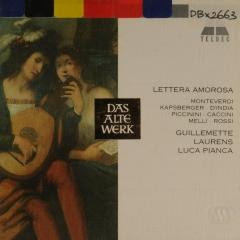
| 1 | Se I Languidi Miei SgardiComposed By – Claudio Monteverdi | 8:30 |
| 2 | Toccata VIComposed By – Giovanni Gerolamo Kapsberger* | 3:01 |
| 3 | Vostro Fui, Vostro Son E Sarò VostroComposed By – Sigismondo D'India | 4:07 |
| 4 | Quella Vermiglia RosaComposed By – Sigismondo D'India | 2:02 |
| 5 | Cruda AmarilliComposed By – Sigismondo D'India | 2:27 |
| 6 | Intenerite Voi, Lagrime MieComposed By – Sigismondo D'India | 2:24 |
| 7 | Ma Che? Squallido E OscuroComposed By – Sigismondo D'India | 2:54 |
| 8 | Toccata XVComposed By – Alessandro Piccinini | 2:48 |
| 9 | Saravanda Alla FranceseComposed By – Alessandro Piccinini | 2:15 |
| 10 | O, Che Felice GiornoComposed By – Giulio Caccini | 3:11 |
| 11 | Disprezzata Regina (Lamento Di Ottavia)Composed By – Claudio Monteverdi | 7:12 |
| 12 | Capriccio CromaticoComposed By – Pietro Paolo Melli | 2:50 |
| 13 | CorrenteComposed By – Pietro Paolo Melli | 1:02 |
| 14 | Tonate, O Miei SospiriComposed By – Luigi Rossi | 5:08 |
VI. Orazio Vecchi: L’Amfiparnaso.(Ensemble Clement Janequin/Dominique Visse). Harmonia Mundi CD 1951461

“Intensely adventurous and exhuberant. […] Sit back and listen as the richness of this Renaissance adventure comes into its own in an interplay of many colors and textures. […] You are left with the sense of having been dropped into the center of a thriving Renaissance city filled with strange and exotic sensations, returning to the real world exhausted but exhilarated. A recommended experience.”
- L’Amfiparnaso
- Il convito musicale
VII. Giorgio Mainerio: Il Primo libro de balli (Consort Veneto). Tactus CD 531301.

Giorgio Mainerio (c.1535-1582) was born in Parma, apparently of Scottish extraction. Although a cleric by training, he was interested in a wide range of subjects, including persistent rumors of occult dealings. The present collection was published in Venice in 1578, apparently the result of a somewhat belated musical carrer on Mainerio's part. It is one of the first significant collections of European folk dances, frequently reprinted in part in later anthologies, without credit to Mainerio. Together with this work, which is becoming better known, Mainerio published a few pieces of liturgical polyphony.
- La Billiarda (4 recorders, 2 bombards, sackbut, dulcian, percussion)
- Pass' e mezzo antico (4 recorders, dulcian)
- Pass' e mezzo della Paganina (2 bombards, sackbut, dulcian, regal, percussion)
- Caro Ortolano (3 bombards, sackbut, 2 percussion)
- Gagliarda (4 recorders, percussion)
- Putta Nera Ballo Furlano (3 bombards, dulcian, 4 recorders, percussion)
- La Zanetta Padoana (2 bombards, sackbut, dulcian)
- La Saporita Padoana (3 recorders, dulcian, percussion)
- Tedescha (3 bombards, dulcian, percussion)
- La Lavandara Gagliarda (2 bombards, sackbut, dulcian, percussion)
- Pass' e mezzo Moderno (2 bombards, sackbut, dulcian, percussion)
- Schiarazula Marazula (hurdy-gurdy, recorder, regal, cornet, 2 bombards, sackbut, percussion)
- Tedescha (4 recorders, percussion)
- Ungarescha (hurdy-gurdy, 3 bombards, dulcian, regal, percussion)
- L'arboscello Ballo Furlano (3 bombards, dulcian, 4 recorders)
- Ballo Milanese (4 recorders, percussion)
- La Parma (4 recorders, percussion)
- Ballo Francese (4 recorders, percussion)
- Ballo Anglese (4 recorders, percussion)
- Tedescha (harpsichord)
- La fiamenga (3 recorders, dulcian, percussion)
- Mainerio / Jakob Paix (1583): Pass' e mezzo antico (harpsichord)
VIII. Landini & Italian Ars Nova (Alla Francesca/Brigitte Lesne). Opus 111 CD 60-9206.

- Amor mi fa cantar alla francesca - Ballata
- Or qua, compagni - Caccia
- I' vo' bene - Ballata
- Lucente stella - Ballata
- Aquila altera - Madrigale
- Adiu, adiu dous dame - Virelai
- Ecco la primavera - Ballata
- Lasso! di donna - Ballata
- La bionda trecca - Ballata
- Belicha - Stampita
- Non so quai i mi voglia - Ballata
- De poni amor - Ballata
- Gram piant' agli occhi - Ballata
- Dal bel castel - Madrigale
- Sento d'amor la fiamma - Balatta
- I' priego amor - Ballata
- Si dolce non sono - Madrigale
IX. I Am Music—Works by Francesco Landini (Ensemble of the 14th Century). Move CD 3091.
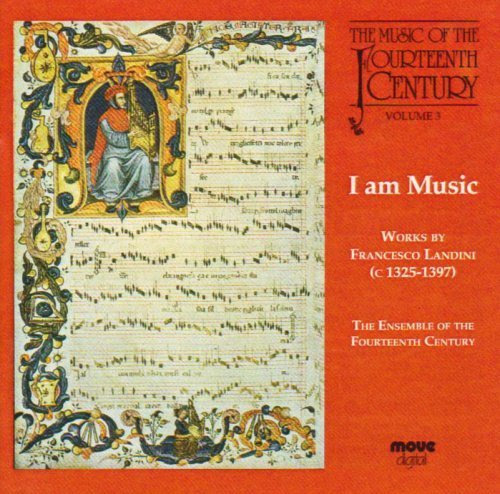
A team of musicologists, literary scholars and performers from Melbourne University and La Trobe University and the Australian Research Council, under the direction of John Stinson and John Griffiths, have collaborated to research and interpret works by principal composers and from the central collections of the fourteenth century. The musical sources of France and Italy in the age of Machaut, Petrarch and Boccaccio include some 1500 works, most of which have never been available on recordings.
In addition to the restoration, research and interpretation of important manuscripts, software developed for the project is currently used in over 30 universities around the world.
The Ensemble of the Fourteenth Century and Les Six are collectives of specialist singers and instrumentalists brought together for the Fourteenth Century Recording Project. Essentially formed around the leading mediaeval ensemble La Romanesca, which has been expanded to provide the varied instrumental and vocal combinations required by the repertory.
1997 marks the 600th anniversary of Francesco Landini's death.
Landini was a poet, polemicist and performing musician whose fame even during his lifetime was equal to that of the greatest artistic figures of his century.
There are many contemporary and near-contemporary accounts of Landini's fame, some attributing him with an almost mythical status. However it is his surviving music manuscripts that reveal the most about Landini, the musician. The music of Francesco Landini is the kernel of every surviving manuscript which documents the music of fourteenth century Italy. However, even now 600 years after Landini's death, less than half his works have been recorded.
This collection presents twelve works not previously recorded as well as fresh readings from some of his most famous works. Most of the madrigals and ballatas featured on this disc deal with love, ranging from the most extroverted manifestations of love to poems of a more contemplative mood, others contain abstract and philosophical ideas pertinent to the time.
- Musica son Francesco Landini 3:11
- Fa metter bando Francesco Landini 4:16
- Deh, pon quest'amor giu! Francesco Landini 6:41
- Altri n'ara Francesco Landini 3:52
- Angelica bilta Francesco Landini 2:20
- Non creder, donna Francesco Landini 4:58
- Vita non e piu misera Francesco Landini 3:19
- Ama, donna, chi t'ama Francesco Landini 4:03
- Amor con fede Francesco Landini 2:49
- Ecco la primavera Francesco Landini 1:01
- Donna, che d'amor senta Francesco Landini 2:29
- Oime 'l core Francesco Landini 7:15
- A le s'andra lo spirto Francesco Landini 4:13
- Che cosa e questa, Amor Francesco Landini 4:06
- Amor in te spera Francesco Landini 2:27
- O fanciulla giulia Francesco Landini 4:48
- Che pena e questa al cor Francesco Landini 3:38
- Or su, gentili spiriti Francesco Landini 4:31
- Si dolce non sono Francesco Landini 3:03
- Contemplar le gran cose Francesco Landini 3:27
X. Il Combattimento(Concentus Musicus Wien/Nicholas Harnoncourt). Teldec CD 92181.
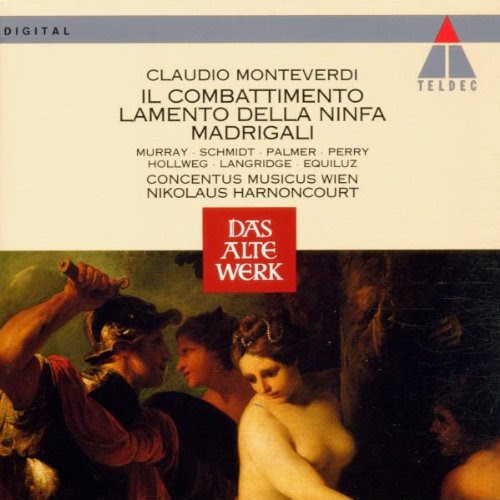
From Amazon: "Sing in time with the soul's affection," Monteverdi used to tell his troupe. There have been more precise instructions from composers - including the great man of the Italian Renaissance himself - but hardly one more delightfully followed by any ensemble.
This account of Il Combattimento di Tancredi e Clorinda, laid down in Vienna some 30 years ago, is supreme. Swoop on it, for the CD has been deleted a long while, it seems, and who knows the recording's fate, considering the pinched purses of record companies.
Il Combattimento sounds as though a composer of genius, given a strict time slot and no great amount of money to spend on a big orchestra, had taken an episode from a 16th-century Italian epic poem, such as Ariosto's Orlando Furioso, and compressed it into 20 minutes or so. Two armed and armoured warriors - a Christian and a heathen, in the age before gunpowder - harangue and belabour each other until one expires. Catholic Europe, of course, required that the Christian triumph and the heathen submit to baptism before death.
So, there's ferocity, but also tenderness - there is no more moving or concise abandonment of life in all music than the final line - and an urgency that compels the attention throughout. There is also, carried over into the piece from a penchant of the said Ariosto, the erotic charge from the fact that one of the combatants turns out to be a woman.
There is no star tenor here unbalancing the interplay of voices, just superb teamwork and musicianship immediately creating the uncompromising emotional world of so long ago and keeping you there.
The other Monteverdi items offered - Lamento della Ninfa, Mentre vaga Angioletta and Ogni Amante è Guerrier - are well chosen for their contrast of voices and topics.
This whole enterprise, under the learned direction of Nikolaus Harnoncourt with the Concentus Musicus Wien, is beyond reproach, with an unerring sense of when not to elaborate.
- Il Combattimento Di Tancredi E Clorinda
- Ogni Amante E Guerrier
- Mentre Vaga Angioletta
- Lamento Della Ninfa (Non Havea Febo Ancora)
XI. Madrigali Amorosi (Deller Consort/Alfred Deller). Vanguard/Bach Guild CD 2519.

Claudio Monteverdi: Madrigali amorosi / Italian Madrigal Masterpieces
Claudio Monteverdi / Marino (t)
Published in Ottavo libro de' madrigali (Madrigali guerrieri, et amorosi ...), Venice, 1638
Altri canti di Marte e di sua schiera (sv155)
94. Part I: Altri canti di Marte e di sua schiera
95. Part II: Due belli occhi fur l'armi onde trafitto
Claudio Monteverdi / Petrarch (t)
Published in Ottavo libro de' madrigali (Madrigali guerrieri, et amorosi ...), Venice, 1638
96. Vago augelletto che cantando vai (sv156)
Claudio Monteverdi / Guarini (t)
Published in Ottavo libro de' madrigali (Madrigali guerrieri, et amorosi ...), Venice, 1638
97. Mentre vaga angioletta (sv157)
Claudio Monteverdi
Published in Ottavo libro de' madrigali (Madrigali guerrieri, et amorosi ...), Venice, 1638
Ninfa che scalza il piede e sciolto il crine (sv160)
98. Part I: Ninfa che scalza il piede e sciolto il crine
99. Part II: Qui deh meco t'arresta, ove di fiori
100. Part III: De l'usate mie corde al suon potrai
Claudio Monteverdi / Guarini (t)
Published in Ottavo libro de' madrigali (Madrigali guerrieri, et amorosi ...), Venice, 1638
101. Dolcissimo uscignolo, 'cantato à voce piena, alla francese' (sv161)
102. Chi vole aver felice e lieto il core, 'cantato à voce piena, alla francese' (sv162)
Claudio Monteverdi / O. Rinuccini (t)
Published in Ottavo libro de' madrigali (Madrigali guerrieri, et amorosi ...), Venice, 1638
Lamento della Ninfa (sv163)
103. Part I: Non avea Febo ancora 'rapresentativo'
104. Part II: 'Amor', dicea, e'l piè
105. Part III: Sí tra sdegnosi pianti
Claudio Monteverdi / O. Rinuccini (t)
Published in Ottavo libro de' madrigali (Madrigali guerrieri, et amorosi ...), Venice, 1638
106. Perchè te'n fuggi, o Fillide? (sv164)
Claudio Monteverdi
Published in Ottavo libro de' madrigali (Madrigali guerrieri, et amorosi ...), Venice, 1638
107. Non partir, ritrosetta (sv165)
108. Su, su, su, pastorelli vezzosi (sv166)
XII. Vespro della Beata Vergine (1610) (Concentus Musicus Wien/Nicholas Harnoncourt). Teldec CD 2564694648.

From Arkiv Music: This disc was recorded some two or three years after the ground-breaking recording by Andrew Parrott, but it could not be more different. Like Parrott, Harnoncourt has recorded the Vespers in the context of a religious service, with the relevant antiphons to the Psalms and to the Magnificat. Harnoncourt’s recording was made live, in Graz Cathedral, and uses all of the associated spatial possibilities. The reading is derived from his examination of the surviving part-books and how the various instrumental parts are notated there; for example for different movements the cornett parts are notated in different part-books. Though Harnoncourt provides an interesting essay in the CD booklet discussing these issues, he does not make any comments about how he decided on the size of his forces.
This is where Harnoncourt starts to differ from Parrott. Parrott uses a small vocal ensemble, whose singers double as soloists, with most movements done one to a part. Whereas the choral forces used here include the Tolz Boys Choir, the Choralschola der Wiener Hofburgkapelle and the Arnold Schoenberg Choir. Add to this a sextet of soloists: Margaret Marshall, Felicity Palmer, Philip Langridge, Kurt Equiluz, Thomas Hampson and Arthur Korn. These are joined by an instrumental group of some three dozen musicians. This means that Harnoncourt and his forces produce a large-scale sound in the bigger pieces. The soloists are all mainstream oratorio/operatic soloists whose repertoire included an element of early performance, rather than the period performance specialists used by Parrott.
At this point we must move towards discarding the Parrott version as a comparison. The two are just too different and their aims too dissimilar. Instead we will have to ask ourselves whether Harnoncourt succeeds on his own terms. Before we completely discard Parrott’s account, we should note that Harnoncourt ignores Parrott’s scholarship and performs the Magnificat and Lauda Sion using high pitch.
Performing with relatively large forces in the apparently resonant acoustic of Graz Cathedral seems to have encouraged Harnoncourt to be relatively sedate with his tempos. Granted, the instrumental interludes have the sort of fizz and bounce that one would expect. But for much of the time the massed choral sections sound positively stolid, without any of the rhythmic impetus that I would have expected. It does not help that the slower speeds and the acoustic tempt Harnoncourt into some positively romantic tempo fluctuations.
XIII. Monteverdi: Selva Morale E Spirituale(La Capelle Ducale/Roland Wilson). Sony Vivarte CD 53363.

| 1 | Dixit Dominus II | 8:24 |
| 2 | Canzon XVII | 4:10 |
| 3 | Confitebor I | 7:24 |
| 4 | Sonata VI | 2:57 |
| 5 | Beatus Vir I | 7:47 |
| 6 | Canzon XIV | 3:56 |
| 7 | Laudate Pueri I | 6:54 |
| 8 | Canzon XII | 2:50 |
| 9 | Laudate Dominum III | 4:24 |
| 10 | Canzon XV | 3:46 |
| 11 | Magnificat I | 12:50 |
| 12 | Canzon I | 4:52 |
| 13 | Salve Regina | 5:51 |
Composer Info
Marco Uccellini, Giulio Caccini, Andrea Falconieri, Claudio Monteverdi, Giuseppe Giordani, Giacomo Carissimi, Cosimo Bottegari, Jacob Jan Van Eyck, Francesco Maria Veracini, Giovanni Giacomo Gastoldi, GIROLAMO FRESCOBALDI, Luigi Rossi, Giovanni Gerolamo Kapsberger, Sigismondo D'India, Alessandro Piccinini, Pietro Paolo Melli, Orazio Vecchi, Giorgio Mainerio (c.1535-1582), Francesco Landini
CD Info
Harmonia Mundi CD 90756, Hungaroton CD HCD31480, Bongiovanni CD 5533, Teldec CD 4617822, Teldec/Das Alte Werk CD 91181, Harmonia Mundi CD 1951461, Tactus CD 531301, Opus 111 CD 60-9206, Move CD 3091, Teldec CD 92181, Vanguard/Bach Guild CD 2519, Teldec CD 2564694648, Sony Vivarte CD 53363
